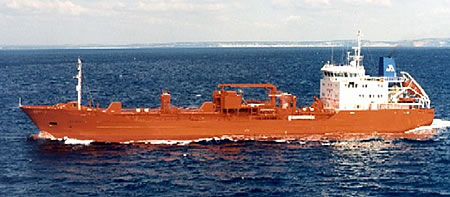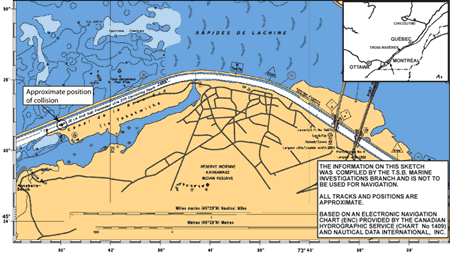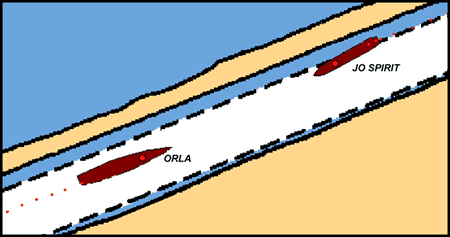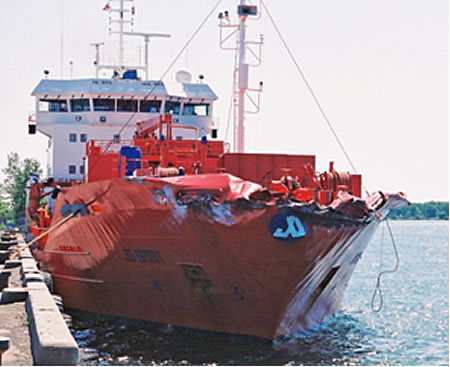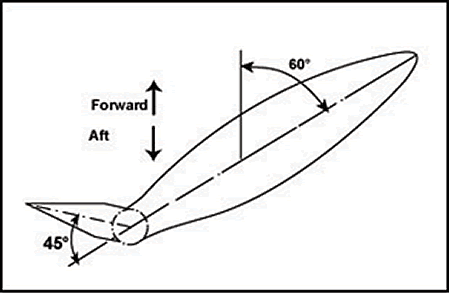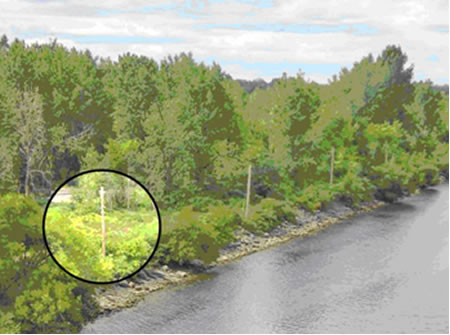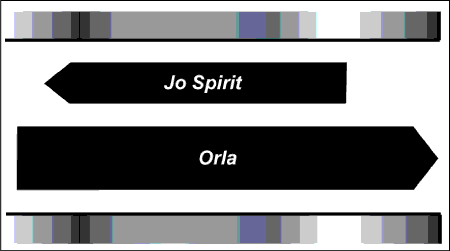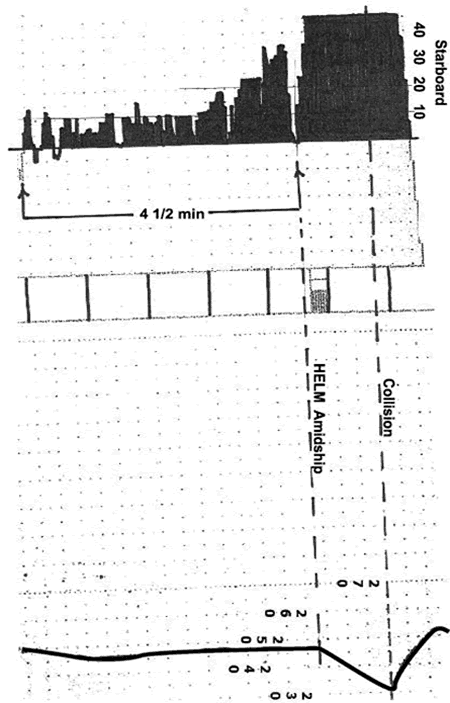Collision
Between the tanker Jo Spirit
and the bulk carrier Orla
South Shore Canal, St. Lawrence Seaway, Quebec
The Transportation Safety Board of Canada (TSB) investigated this occurrence for the purpose of advancing transportation safety. It is not the function of the Board to assign fault or determine civil or criminal liability. This report is not created for use in the context of legal, disciplinary or other proceedings. See Ownership and use of content. Masculine pronouns and position titles may be used to signify all genders to comply with the Canadian Transportation Accident Investigation and Safety Board Act (S.C. 1989, c. 3).
Summary
At 2243 eastern daylight time on 19 July 2005, in fine weather and darkness, the upbound vessel Jo Spirit and the downbound vessel Orla collided near Mile 16 of the South Shore Canal in the St. Lawrence Seaway.
The collision occurred near mid-channel at a combined speed of approximately 6 knots. Both vessels sustained damage forward, but neither injuries nor pollution resulted.
Factual information
Particulars of the vessels
| Vessel name | Jo Spirit | Orla |
|---|---|---|
| IMO number | 9140841 | 9154270 |
| Port of registry | Bergen, Norway | Valletta, Malta |
| Flag | Norway | Malta |
| Type | Tanker | Bulk carrier - general cargo |
| Gross tonnage | 4425 | 11 848 |
| LengthFootnote 1 | 107.4 m | 149.5 m |
| Draught | Forward: 6.15 m Aft: 6.45 m |
Forward: 8.00 m Aft: 7.99 m |
| Built | 1996 | 1999 |
| Propulsion | B&W diesel engine, 3570 kW, driving a single controllable-pitch propeller | B&W diesel engine, 4710 kW, driving a single fixed-pitch propeller |
| Cargo | Rum in bulk | Wheat |
| Crew | 16 | 19 |
| Registered owner(s) | Jo Tankers AS, Bergen, Norway | Polish Steamship Company, Szczacin, Poland |
Description of the vessels
Orla
The Orla is a conventional geared bulk carrier of recent construction with the engine room and accommodation aft.
Jo Spirit
The Jo Spirit is a tanker with the engine room and accommodation aft. Vessel movements, either ahead or astern, are controlled from the wheelhouse using a controllable-pitch control unit. The controllable-pitch control was slightly offset such that, when the control lever was set at zero pitch, the vessel would make headway estimated at between 1 and 3 knots. The vessel was also equipped with a bow thruster.
History of the voyage
At approximately 1955 eastern daylight timeFootnote 2 on 19 July 2005, a pilot boarded the Jo Spirit at Saint-Lambert, Quebec, in the first lock of the St. Lawrence Seaway to conduct the vessel up the South Shore Canal. Visibility was reported as very good with a light breeze. After the vessel departed Côte-Sainte-Catherine lock at 2143, the second lock of the Seaway, the master left the bridge. The pilot, the officer of the watch (OOW), and the helmsman continued the navigation upbound (heading southwest).
At 2220, the pilot of the downbound (heading northeast) vessel Orla reported passing Saint-Nicolas Island. The Seaway Beauharnois traffic control officer informed him that the Jo Spirit was upbound under the Canadian Pacific Railway (CPR) bridge.
At 2237, the pilots of the two vessels spoke on the very high frequency (VHF) traffic control channel. The communication was of a personal nature and not related to the meeting situation that was to occur. At this time, the Jo Spirit was rounding the final upbound bend in the South Shore Canal, about 1 nm above the CPR bridge. The Orla was proceeding on the mid-channel course of 068.5° true (T) at the western entrance to the South Shore Canal.
Shortly after rounding the final upbound bend in the South Shore Canal, it appeared to the pilot of the Jo Spirit that the Orla was slightly crowding the north side of the channel on which he was conducting the tanker. Accordingly, he decided to give a little more room for the meeting to take place by moving closer to the north bank, but he communicated his intentions to neither the pilot of the Orla nor to the Jo Spirit's navigation personnel. When satisfied with the vessel's position in the channel, he asked the helmsman to steer 248° gyro (G). The helmsman complied but found that the vessel needed regular inputs of 5 to 10° starboard helm in order to maintain the heading. The OOW was now standing by the helmsman, verifying his actions.
Between 2239 and 2240, more than 10° starboard helm was applied to maintain the heading. By 2241, 20° to 30° starboard helm was necessary to steer 248° (G).Footnote 3 During this time, the pilot glanced at the rudder angle indicator from time to time, but there was no exchange of information among bridge team members. As the Jo Spirit made its way along the channel bank, the pilot gradually reduced the propeller pitch to slow the vessel down before the meeting. Since completing the final upbound bend at 7.6 knots,Footnote 4 the vessel was now making 5.7 knots.
There is conflicting information with respect to the helm orders given at about 2242. The navigation personnel of the Jo Spirit maintain that the pilot ordered the helm amidships, whereas the pilot does not recollect this order. The helm was nonetheless put to midships (see Appendix A), and the vessel immediately started to sheer to port. Full starboard helm was then applied, but the vessel's heading continued to swing to port. Starboard bow thrust was reportedly requested by the pilot, but was not applied.
The bridge team of the Orla consisted of a pilot, master,OOW, and the helmsman. The engine telegraph was set at "dead slow ahead" and the vessel, thought to be in the centre of the channel, was under the conduct of the pilot who was giving the helmsman courses to steer. Upon seeing the Jo Spirit sheer toward the middle of the channel, the pilot ordered the helm put to starboard and then, just before the collision, hard to port was applied to try to minimize the angle of contact. The main engine was then stopped.
At about 2243, on a heading of 232° (G), the Jo Spirit made contact with the Orla in position latitude 45°24′43″ N and longitude 073°42′21″ W, approximately 0.51 nm upstream of Mile 16 of the South Shore Canal (see Figure 1).
Vessel positions before the collision
Most commercial vessels transiting the St. Lawrence Seaway, including the two vessels involved, are required to have a functional Automatic Information System (AIS).Footnote 5 Vessel position information was obtained from an external source for both the Jo Spirit and the Orla.
The Jo Spirit was also equipped with an electronic chart system (ECS), and the position information on the ECS confirmed the AIS data for the Jo Spirit. The Orla was not fitted with an ECS, but carried two global positioning system (GPS) units. However, these had no electronic interface and were not being used for navigational purposes, and the pilot was navigating using visual cues.Footnote 6
Figure 2 illustrates the relative positions of the vessels, based on the AIS data, just before the Jo Spirit took the sheer to port. The data also indicate that, between 2233 and 2241, the Orla was making a course over the ground (COG) that would bring the vessel toward the north side of the channel - that is, a COG less than the channel direction of 068.5° (T).
Width of vessels and the canal
The canal area where the collision took place has a usable navigable width of approximately 70 m. The Jo Spirit has a moulded breadth of 15.9 m, while the Orla is 23 m wide.
Vessel certification
The Jo Spirit and the Orla were crewed, certificated, and equipped in accordance with existing regulations.
Personnel certification
The master and officers of the Jo Spirit and the Orla held appropriate certificates for the type of vessel and class of voyage.
Personnel history
Jo Spirit
The pilot had been employed as such since 1990. Before becoming a pilot, he had sailed as master. The master of the Jo Spirit had sailed as master on various vessels since 1983. He had been master on the Jo Spirit for four years. The OOW had been sailing as a deck officer since 1991, while the helmsman had been sailing since 1990. Both the pilot and the master had received training in bridge resource management (BRM).
Orla
The pilot had been employed as such since 1995. Before becoming a pilot, he had sailed as master. The master of the Orla had been sailing since 1970, and had sailed as master on various vessels for the past 20 years. The OOW had been sailing in his present capacity since 004, and the helmsman, since 1971.
Injuries to persons
There were no reported injuries on either vessel.
Damage to the vessels and environment
Jo Spirit
The side shell plating of the Jo Spirit in way of the forecastle was set in and gashed.
Orla
Damage to the Orla included a large hole above the waterline in way of the forward paint stores. A minor fire forward caused by sparks was quickly extinguished.
There was no pollution.
Rudder movement and rudder angle recorder - Jo Spirit
The Jo Spirit is equipped with a Becker rudder. When such a rudder is turned to any given angle up to a maximum of 60°, an articulated flap also moves in relation to the plane of the main blade up to an additional 45°. The ratio of flap angle to main rudder angle is variable, being greatest at small rudder angles and then diminishing. A 5° main rudder application, for example, will produce almost 12° of flap angle, while a 45° main rudder application will result in 45° of flap angle. This type of rudder has the effect of increasing the lift coefficient dramatically, and the resulting side force is almost 80 per cent greater than conventional rudders. Maximum side force of the Becker rudder is achieved at about 34° on the main rudder, with a corresponding flap angle of about 43°.
The Jo Spirit is also equipped with a C. Plath rudder angle recorder (see Appendix A). Although the maximum rudder angle achievable is 60° (port or starboard), the rudder angle recorder in the wheelhouse is only capable of recording to a maximum of 45° (port and starboard). Any rudder angles used that are greater than 45° are also recorded as 45°. On the other hand, the rudder angle indicator used by the bridge team to view helm application is graduated to the full extent of rudder movement - that is, 60°.
Night navigation in the South Shore Canal
The South Shore Canal is fitted with variable-intensity lighting that outlines the banks of the canal.Footnote 7 The system extends from the Jacques Cartier Bridge in the east to the end of the dyke at Kahnawake (Lac Saint-Louis) in the west. Light intensity can be controlled from Côte-Sainte-Catherine and increased during periods of reduced visibility. Night navigation in the canal is essentially carried out using the visual cues taken from the lighting arrangements. Although the north shore light posts were, for the most part, easily visible and clear of any trees or other obstructions, those on the south side were not. Especially above Côte-Sainte-Catherine lock, many lamppost lights were extinguished, and had been for some time, while others were obstructed by trees and bushes.
Bank suction
As a vessel moves forward, displaced water produces a cushion effect at the bow, before filling the void behind the stern. Lateral pressures are balanced. When a ship is off the channel centreline, a yawing moment is produced. The elevation of the water between the vessel and the near bank of the channel is less than the other side, and the resultant force tends to move the stern toward the near bank. This effect is known as bank suction; its magnitude is influenced by other factors, including vessel distance from the bank, vessel speed, water depth, draft, and channel profile.Footnote 8
Collisions in narrow channels due to one vessel taking a sheer as a result of bank suction effect are well documented. In 2002, while outbound in the Houston Ship Channel, the vessel Lindholm took an unrecoverable sheer to port and collided with the inbound Stolt Achievement.Footnote 9 In 2003 at Townsville, Queensland, Australia, a tanker sheered to port across the channel and grounded when starboard rudder, which was being used to counteract the bank suction effect aft, was removed.Footnote 10 Similarly, the P&O Nedlloyd Genoa and the Ebro collided on Germany's Elbe River in 2002 when the P&O Nedlloyd Genoa sheered irreversibly to port after starboard helm was removed.Footnote 11
Bridge Resource Management
Bridge resource management is the effective management and utilization of all resources, human and technical, available to a bridge team to help ensure the safe operation of a vessel. It focuses on skills such as communication and team building.
Weakness in bridge organization and management has been cited as the primary cause of marine casualties worldwide. When the pilot is on board, he/she must participate in and be supported as a temporary bridge team member.
Good bridge resource management also involves effective inter-ship communication, especially in narrow channels.Footnote 12
Analysis
Bank suction and vessel manoeuvring
Five minutes before the collision, the Jo Spirit was already very close to the channel's north bank and experiencing increased bank suction aft. More and more starboard helm was therefore necessary to maintain the required heading. Although the high side forces generated by the Becker rudder could counteract the increasing bank suction, they also allowed the situation to persist. As soon as the rudder was placed amidships, however, the counteracting forces generated by the rudder were lost and the vessel sheered to port.
According to data obtained from the AIS, the Orla crossed the channel's centreline and moved to the north side at some time before the collision. This is consistent with the observation of the pilot of the Jo Spirit that the Orla was crowding the north side of the channel.
Given moulded breadths of 15.9 m and 23 m, respectively, the Jo Spirit and Orla would take up much of the available manoeuvring space in a channel only 70 m wide. Figure 4 shows a meeting between these two vessels in which maximum even space is maintained between the vessels, and also between each vessel and the channel bank. Even in this ideal case, however, only approximately 10 m would exist between the vessels and between each vessel and the bank - a tight fit given the size of the vessels.
Communication between pilots
The conduct of vessels in narrow channels, which is governed by the International Regulations for Preventing Collisions at Sea, 1972, requires that each vessel keep, as far as is safe and practical, to the starboard side of the channel.Footnote 13 However, it is the accepted practice when meeting in very narrow channels that both vessels "stand on" near mid-channel for as long as possible before each alters to starboard. This is common practice in the South Shore Canal and not only allows the vessels to benefit from the bow cushion effect as they meet, but reduces the incidence of bank suction at the stern before the meeting. In this instance, the Orla was crowding the manoeuvring space of the Jo Spirit before the collision and influenced the pilot of the Jo Spirit to move farther to the north side of the channel, and at an earlier time than desirable. However, he did not communicate these concerns to either the bridge team or the pilot of the Orla. The pilots had been in communication, but discussed non-navigational matters.
Night navigation in the South Shore Canal
Night navigation within the South Shore Canal is primarily dependent on visual cues taken from lights mounted on wooden lampposts on either side of the channel (see Photo 4). Above Côte-Sainte-Catherine lock, many lights were extinguished, and had been for some time. Others were obstructed by trees and bushes, a situation that reduces the spatial orientation of the bridge team. The reduced shore-side lighting, therefore, may have hampered the ability of the pilots of both vessels to accurately assess their respective vessel's position within the channel in the minutes leading up to the collision.
Furthermore, a ship's radar is unable to give accurate information with respect to distances off canal banks in narrow channels and, if there is no other system (such as an ECS) aboard, greater reliance must be placed on the shore aids and visual cues - in this case, the lamppost lights and the visual observation of the canal bank. The Orla was not fitted with an ECS and the pilot, relying on visual aids, believed the vessel to be in the centre of the channel, whereas it was actually north of the centreline and closing toward the north bank.
The St. Lawrence Seaway is an important North American transportation infrastructure. Given the very small margin of error for vessels meeting in this location, and with the potential for serious consequences in the event of an accident, visual night navigation in this sector of the Seaway is dependent upon the sufficiency, reliability, and adequate maintenance of lamppost-mounted lights and their visibility from both channel directions.
Bridge Resource Management
Successful BRM requires full and complete communication among the team so that all members share the same mental model and have a common understanding of the situation. Using command/order confirmation is an effective way to achieve this. When communication is less than adequate, the efficacy of the bridge team is reduced and risks increase.
During the several minutes preceding the sheer to port, increasing amounts of starboard helm were applied to steer the Jo Spirit parallel to the channel and counteract the bank suction effect. Given the high efficiency of a Becker rudder, using 30°, 20°, or even 10° of helm to steer a straight course is an unusual requirement. Nonetheless, neither the helmsman nor the OOW, who were closely monitoring the situation, communicated to the pilot the amount of helm action being used. The pilot of the Jo Spirit was not closely monitoring the rudder angle indicator and was not aware that excessive helm was being used to maintain the vessel's heading. Furthermore, there is conflicting information regarding the amidships helm order that precipitated the sheer to port.
Effective BRM could have ensured that the bridge team on the Jo Spirit had a common understanding of the situation. Instead, the pilot was operating in isolation, and an opportunity to take remedial measures was lost.
Given the tight fit in the channel, inter-ship communication was critical, particularly as inadequate shore-side lighting may have reduced visual cues.
In this instance, although he believed correctly that the Orla was over the channel's centreline, the pilot of the Jo Spirit did not confirm this with the Orla's pilot. The pilots had been in communication, but were discussing non-navigational matters.
Findings
Findings as to causes and contributing factors
- The Orla was navigating to the north of the centre of the channel, and the pilot of the Jo Spirit reacted by moving closer to the north bank of the channel to allow more manoeuvring room.
- The bank suction effect on the Jo Spirit became progressively pronounced, requiring increasing starboard helm; the placing of the helm to amidships caused the vessel to sheer to port.
- There was no relevant communication between the pilots of the two vessels throughout the developing situation.
- Ineffective bridge resource management (BRM) aboard the Jo Spirit resulted in critical information not being shared with the pilot, thus precluding timely action.
- Inadequate shore-side lighting, combined with the overgrowth of trees and bushes, may have hampered the ability of both pilots to accurately assess their respective vessel's position within the channel.
Other findings
- The controllable-pitch control unit of the Jo Spirit was offset such that, at the zero pitch setting, the vessel would continue to make headway.
- Although the Jo Spirit's helm indicator was graduated to the full 60° of rudder angle, the rudder angle recorder was only graduated to a maximum of 45°.
- Starboard bow thrust was reportedly requested by the pilot of the Jo Spirit when the Jo Spirit sheered to port, but was not applied. It is unlikely, however, that the application of the bow thruster at this time would have changed the outcome of this occurrence.
Safety action
Action taken
Transportation Safety Board of Canada
On 03 August 2005, Marine Safety Information Letter 01/05, Vessels Meeting in Restricted Channels, was sent to the Great Lakes Pilotage Authority to inform it of the facts concerning the occurrence and to reiterate the importance of vessels adhering to standard meeting procedures.
On 14 October 2005, Marine Safety Information Letter 04/05, Less Than Adequate Visual Aids for Night Navigation in the South Shore Canal, was sent to the St. Lawrence Seaway Management Corporation (SLMC). The letter brought attention to the numerous non-functioning lights reported on the south side of the channel above Côte-Sainte-Catherine, as well as the growth of trees and shrubs that reduces the visibility of functioning lights.
In response, the SLMC advised that work was completed by 31 October 2005 on bank lighting circuits 7, 8, and 10, as well as brushing and tree trimming along the channel above Côte-Sainte-Catherine lock, to improve the quality of visual aids for night navigation. Work on circuit 9 was completed in 2006. Additionally, the SLMC has stated that the corporation will improve its water-side inspections to better target its tree-trimming/cutting program and thus ensure proper visibility of the canal bank sides and lights from vessels at night.
Jo Tankers AS, Norway
Following the occurrence, the company conducted an in-house investigation. A new familiarization task was added to the checklist for deck officers and helmsmen. An information binder on the rudder and its performance characteristics was compiled and is now kept in the wheelhouse. Additionally, a small working model of the Becker rudder is mounted in the wheelhouse to demonstrate functionality.
Helmsmen are now instructed to put the rudder to 35° when "hard over" helm is requested (since maximum side thrust is achieved at this angle). If, during manoeuvring at slow speeds, rudder angles of 60° are needed so the rudder can act as a stern thruster, the order "full helm" is to be used.
The company also conducted refresher bridge resource management (BRM) training for all officers using the collision case of the Jo Spirit as a model with a focus on intervention and challenging pilot's action.
Polska Zegluga Morska, Poland
In response to the occurrence, an internal investigation was held and the conclusions were shared with the company's masters. Relevant procedures within the safety management system were amended and implemented.
Great Lakes Pilotage Authority
Through the use of a marine navigation simulator, the Great Lakes Pilotage Authority has instituted training exercises for its pilots of vessels meeting in the South Shore Canal at night.
This report concludes the Transportation Safety Board's investigation into this occurrence. Consequently, the Board authorized the release of this report on .

